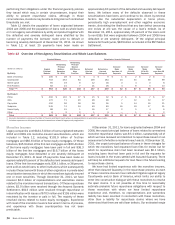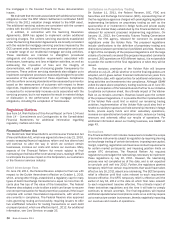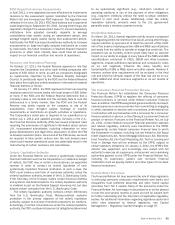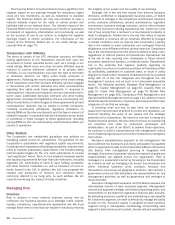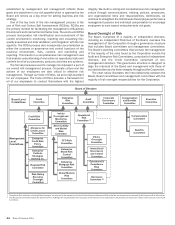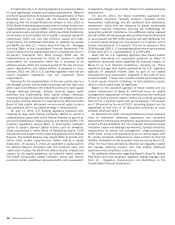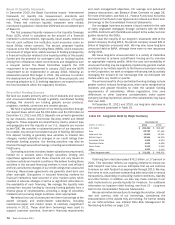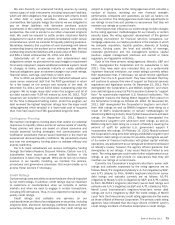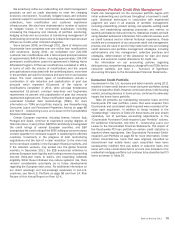Bank of America 2011 Annual Report Download - page 67
Download and view the complete annual report
Please find page 67 of the 2011 Bank of America annual report below. You can navigate through the pages in the report by either clicking on the pages listed below, or by using the keyword search tool below to find specific information within the annual report.Bank of America 2011 65
Our Board’s Audit, Credit and Enterprise Risk Committees have
the principal responsibility for assisting the Board with enterprise-
wide oversight of the Corporation’s management and handling of
risk.
Our Audit Committee assists the Board in the oversight of,
among other things, the integrity of our consolidated financial
statements, our compliance with legal and regulatory
requirements, and the overall effectiveness of our system of
internal controls. Our Audit Committee also, taking into
consideration the Board’s allocation of the review of risk among
various committees of the Board, discusses with management
guidelines and policies to govern the process by which risk
assessment and risk management are undertaken, including the
assessment of our major financial risk exposures and the steps
management has taken to monitor and control such exposures.
Our Credit Committee oversees, among other things, the
identification and management of our credit exposures on an
enterprise-wide basis, our responses to trends affecting those
exposures, the adequacy of the allowance for credit losses and
our credit related policies.
Our Enterprise Risk Committee, among other things, oversees
our identification of, management of and planning for, material
risks on an enterprise-wide basis, including market risk, interest
rate risk, liquidity risk, operational risk and reputational risk. Our
Enterprise Risk Committee also oversees our capital management
and liquidity planning.
Each of these committees regularly reports to our Board on
risk-related matters within the committee’s responsibilities, which
collectively provides our Board with integrated, thorough insight
about our management of our enterprise-wide risks. At meetings
of our Audit, Credit and Enterprise Risk Committees and our Board,
directors receive updates from management regarding enterprise
risk management, including our performance against our risk
appetite.
Executive management develops for Board approval the
Corporation’s Risk Framework, Risk Appetite Statement, and
financial operating plans. Management monitors, and the Board
oversees, through the Credit, Enterprise Risk and Audit
Committees, financial performance, execution of the strategic and
financial operating plans, compliance with the risk appetite, and
the adequacy of internal controls.
Strategic Risk Management
Strategic risk is embedded in every business and is one of the
major risk categories along with credit, market, liquidity,
compliance, operational and reputational risks. It is the risk that
results from adverse business decisions, ineffective or
inappropriate business plans, or failure to respond to changes in
the competitive environment, business cycles, customer
preferences, product obsolescence, regulatory environment,
business strategy execution and/or other inherent risks of the
business including reputational and operational risk. In the
financial services industry, strategic risk is elevated due to
changing customer, competitive and regulatory environments. Our
appetite for strategic risk is assessed within the context of the
strategic plan, with strategic risks selectively and carefully
considered in the context of the evolving marketplace. Strategic
risk is managed in the context of our overall financial condition
and assessed, managed and acted on by the CEO and executive
management team. Significant strategic actions, such as material
acquisitions or capital actions, require review and approval of the
Board.
Executive management approves a strategic plan every two to
three years. Annually, executive management develops a financial
operating plan that implements the strategic goals for that year,
and the Board reviews and approves the plan. With oversight by
the Board, executive management ensures that the plans are
consistent with the Corporation’s strategic plan, core operating
tenets and risk appetite. The following are assessed in their
reviews: forecasted earnings and returns on capital, the current
risk profile, current capital and liquidity requirements, staffing
levels and changes required to support the plan, stress testing
results, and other qualitative factors such as market growth rates
and peer analysis. At the business level, as we introduce new
products, we monitor their performance to evaluate expectations
(e.g., for earnings and returns on capital). With oversight by the
Board, executive management performs similar analyses
throughout the year, and evaluates changes to the financial
forecast or the risk, capital or liquidity positions as deemed
appropriate to balance and optimize between achieving the
targeted risk appetite, shareholder returns and maintaining the
targeted financial strength.
We use proprietary models to measure the capital requirements
for credit, country, market, operational and strategic risks. The
economic capital assigned to each business is based on its unique
risk exposures. With oversight by the Board, executive
management assesses the risk-adjusted returns of each business
in approving strategic and financial operating plans. The
businesses use economic capital to define business strategies,
price products and transactions, and evaluate client profitability.
For additional information on how this measure is calculated, see
Supplemental Financial Data on page 32.
Capital Management
Bank of America manages its capital position to ensure capital is
sufficient to support our business activities and that capital, risk
and risk appetite are commensurate with one another, ensure
safety and soundness under adverse scenarios, take advantage
of growth and strategic opportunities, maintain ready access to
financial markets, remain a source of strength for its subsidiaries
and satisfy current and future regulatory capital requirements.
To determine the appropriate level of capital, we assess the
results of our Internal Capital Adequacy Assessment Process
(ICAAP), the current economic and market environment, and
feedback from investors, rating agencies and regulators. Based
upon this analysis we set capital guidelines for Tier 1 common
capital and Tier 1 capital to ensure we can maintain an adequate
capital position in a severe adverse economic scenario. We also
target to maintain capital in excess of the capital required per our
economic capital measurement process. For additional
information, see Economic Capital on page 69. Management and
the Board annually approve a comprehensive Capital Plan which
documents the ICAAP and related results, analysis and support
for the capital guidelines, and planned capital actions and capital
adequacy assessment.



